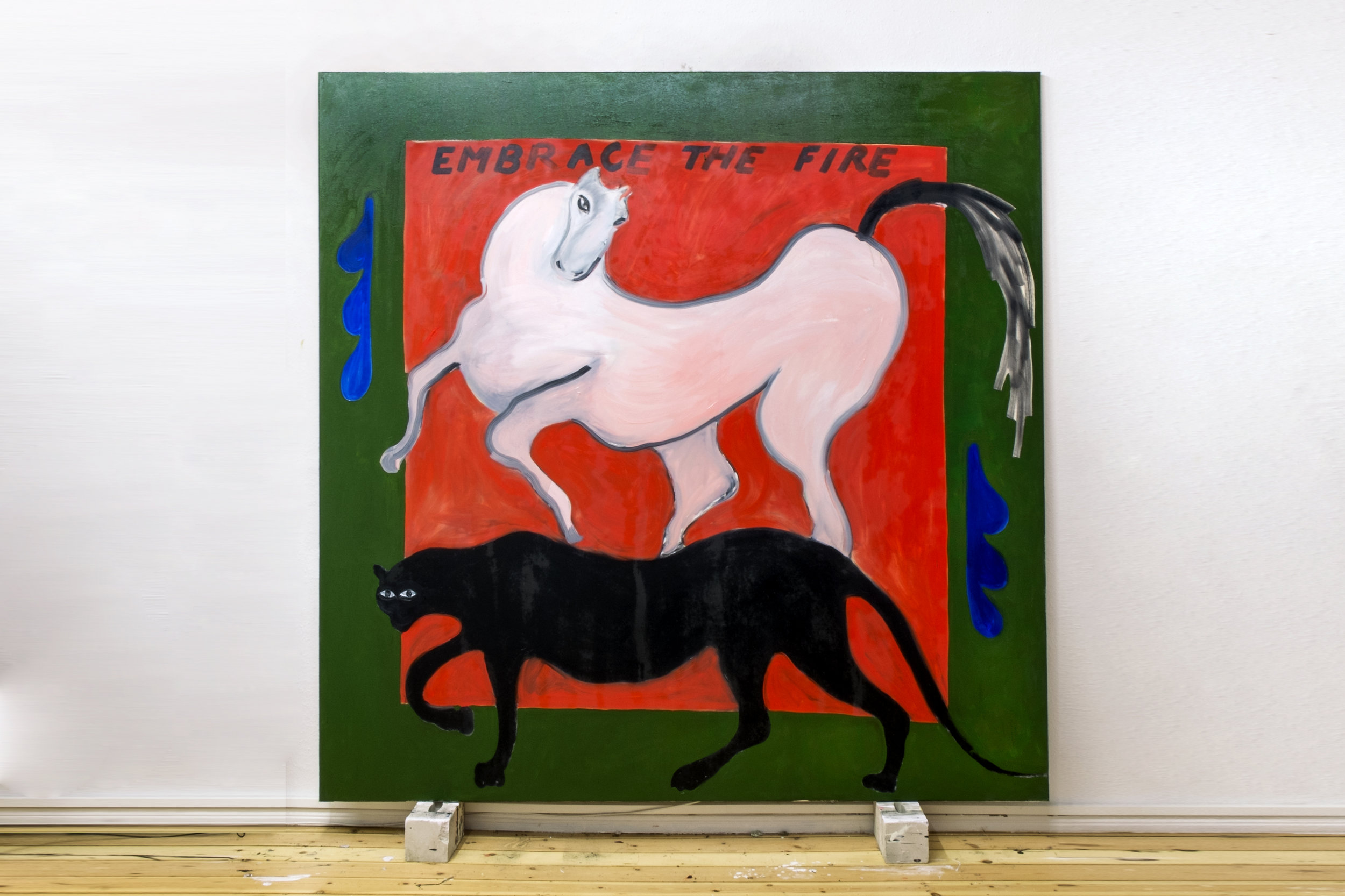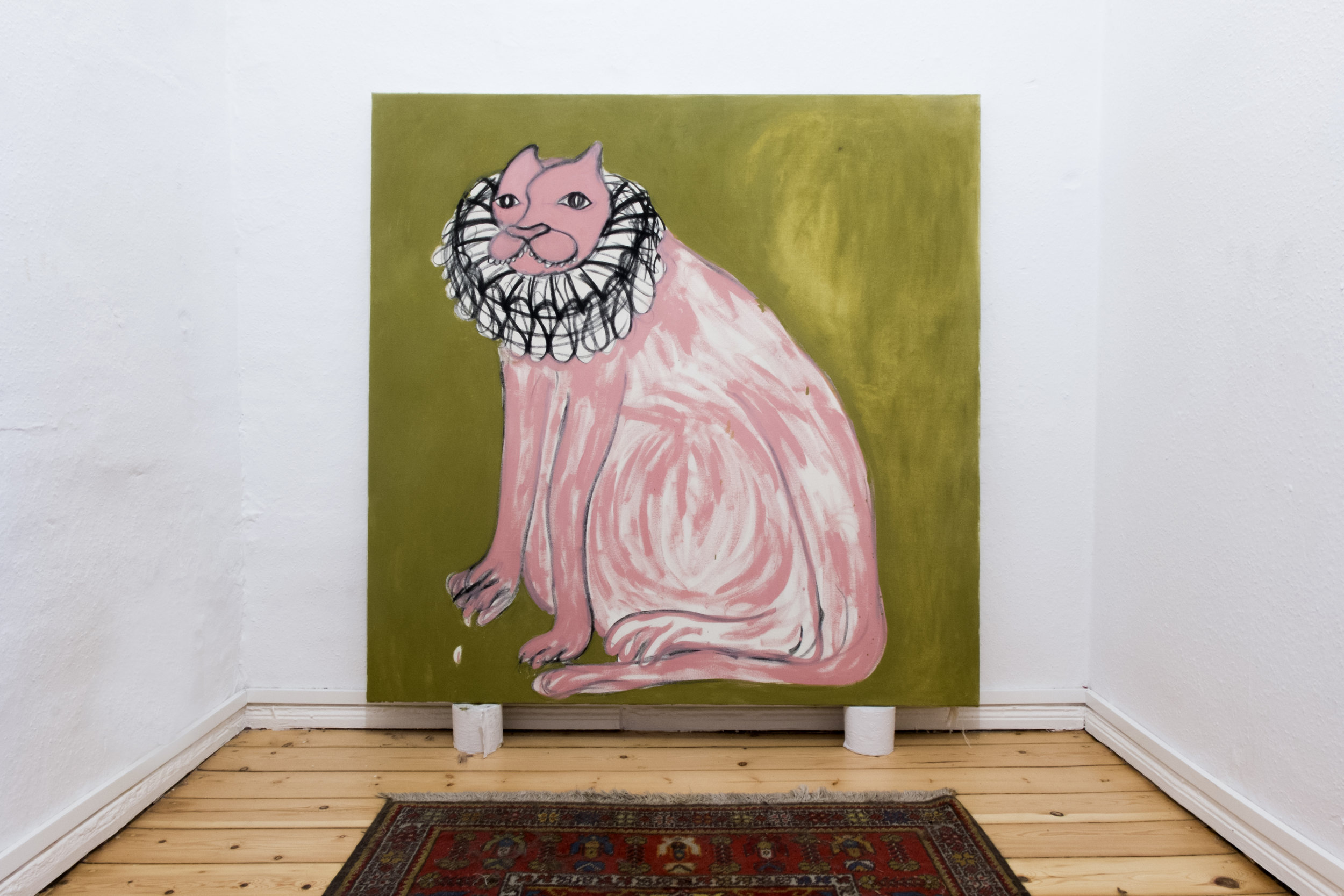Sophie Vallance

"by addressing anxiety, i’m hoping to transform vulnerability into power, whether its through humour or seriousness, it definitely helps me alter how i’m feeling."
Interview by writer Stephen Feather
Could you tell us a bit about yourself and your background? Where did you study?
I was born in Scotland, grew up in Cornwall, studied my first year of Panting at Wimbledon College of Arts, my second year at Camberwell College of Arts, then had to leave in order to be able to stay living in the same country as my husband Douglas, (Theresa May’s ridiculous financial restrictions on non EU spouses) and have lived in Berlin for two and half years now. At this point I don’t really feel like I’m from anywhere as a person or a painter, I don’t identify my practise with any institution I’ve studied at, I feel sort of like a sponge, taking what I choose from each new situation, rather than feeling defined by it.
You’ve said that anxiety and everyday life have been key influences in your work. Do you find this process of engagement therapeutic?
It is definitely a strongly cathartic process to make paintings about everyday life and particularly personal struggle within everyday life. Making paintings is basically making a series of decisions, and its one of the only things in life that makes me be really present with what i’m doing, so the act of painting as well as the subject matter ends up being therapeutic. Ultimately, by addressing anxiety, i’m hoping to transform vulnerability into power, whether its through humour or seriousness, it definitely helps me alter how i’m feeling.
"A Painting For Douglas" 2018
"Wedding Portrait" 2018
"Mother Fokker" 2017
You’ve mentioned that your attitude to your work can change after spending some time away from it. Is it hard to separate any changes in attitude towards the ideas in an artwork and the artwork itself? What kind of conflicts arise from this process?
Usually when I take time away from a work what happens is that I can see it clearly for the first time. When i’m in the act of actually making a painting it’s too tangled with me, but with space and time I don’t always recall the way I was feeling when I was making it. I usually work quickly in intense bursts of painting, with longer periods of breathing space between, so when I come back to look at a work in progress after some time, I usually know exactly what isn’t working. If i’ve decided a work is finished though, I tend to not dwell on what isn’t working, because each painting is of it’s moment, they’re not all going to be amazing, but they are what they are, and that is valuable enough.
You’ve worked with your husband, Douglas Cantor, on joint artistic projects. How does collaboration help and inform your practise?
Douglas and I share a studio, share a profession and share our lives. We’re incredibly close, but are definitely two individual artists. Of course there is a bleed between our practises in some ways, which i think would be dishonest to try to avoid. When you spend so much time around each others work, and each other, also experiencing life in the same place at the same time, there is bound to be connections between our practises. The same colours and symbolism often appear in both of our works, and stealing both of these things from one another we kind of actively enjoy. I’ve had people say to me that we both “make the same kind of work” but I always feel that they are not looking close enough if they think that. Douglas and I are very different at our cores, we are from very different places, but we are both pointing in the same direction in life, and that is heavily embedded in the way we examine the subject matter in our work. In the end, we keep each other true to ourselves and keep each other honest in our work.
"I'm Right Where I Should Be" 2018
Tell us a bit about how you spend your day / studio routine? What is your studio like?
I share my studio with Douglas and it’s in our apartment in Berlin. Up until this point having my studio and my home be one thing has been really positive for me, it has meant I can abandon the need to schedule when studio time can take place, I can strike when the iron is hot if I get an idea or want to make a change to a painting at a random moment. Of course there are downsides, as we make more paintings we need to find space to store them and it is getting to the point where we are in need of a bigger space.
I love sharing my studio with Douglas and the intimacy of making paintings next to another painter. In other areas of my life I use things like to-do lists, but in the studio it would feel counterproductive to force that on the work, so I just dedicate time. Sometimes it’s just a day of thinking, or looking at images, other days I will make a painting in one go. There are also the perks of being able to potter about and have lunch or take a shower between layers of primer drying because the studio and house are one. In essence I just prioritise myself and my time to my practise in the studio, and then the rest comes.
"King Botoño II" 2017
"Gae Yersel Peace" 2018
"30 Million Pelitos, One Pelito at a Time" 2018
How do you go about naming your work?
I don’t just draw visual influences from other paintings and painters, I collect images that could be of anything from fashion to patterned tiles to old Japanese cartoons, so I’m always collecting, and dissecting things I’ve already seen, I also do the same with writing, I note down interesting phrases I overhear people say in real life, that I hear in songs or in random tv shows. A lot of my titles are either stolen from somewhere else, or have occurred in conversation between me and Douglas, so some of them may not make much sense to other people, but act as a sort of intimate inside joke from the time they were made.
What artwork have you seen recently that has resonated with you?
I was having a terrible day, and walking home I literally looked up and saw three paintings by Grace Weaver through the window of a gallery. It was like a little present from the universe to look up and and see them so unexpectedly. I’d never seen her work in person and standing looking at them totally brought me perspective on my bad day, something I deem really powerful in such a simple way.
Is there anything new and exciting in the pipeline you would like to tell us about?
My work is currently being exhibited in Predatory Behavior at T293 in Rome, the show will run for another five weeks, I have also been accepted onto the NARS Foundation Residency in New York City for three months in Summer 2019.
Published: 10/07/2018
All images courtesy of the artist


